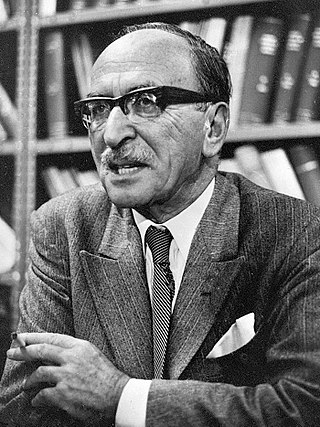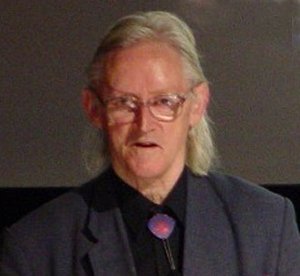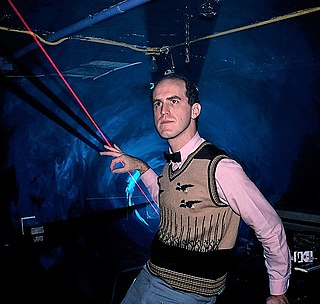
Holography is a technique that enables a wavefront to be recorded and later reconstructed. It is best known as a method of generating three-dimensional images, and has a wide range of other uses, including data storage, microscopy, and interferometry. In principle, it is possible to make a hologram for any type of wave.

Dennis Gabor was a Hungarian-British electrical engineer and physicist who invented holography, for which he received the 1971 Nobel Prize in Physics. He obtained British citizenship in 1934, and spent most of his life in England.

The Holodeck is a fictional device from the television franchise Star Trek which uses "holograms" to create a realistic 3D simulation of a real or imaginary setting, in which participants can freely interact with the environment as well as objects and characters, and sometimes a predefined narrative.

Holographic data storage is a potential technology in the area of high-capacity data storage. While magnetic and optical data storage devices rely on individual bits being stored as distinct magnetic or optical changes on the surface of the recording medium, holographic data storage records information throughout the volume of the medium and is capable of recording multiple images in the same area utilizing light at different angles.
Lloyd Cross is an American physicist and holographer.
"Flesh and Blood" is a two-part episode from the seventh season of the science fiction television series Star Trek: Voyager. The crew of USS Voyager must contend with violent Delta Quadrant aliens the Hirogen, who use the holodeck technology with a horrific amoral twist.

Stephen Anthony Benton was the inventor of the rainbow hologram and a pioneer in medical imaging and fine arts holography. Benton held 14 patents in optical physics and photography, and taught media arts and sciences at Massachusetts Institute of Technology (MIT). He was the E. Rudge ('48) and Nancy Allen Professor of Media & Sciences, and the Director for Center for Advanced Visual Studies (CAVS) at MIT.

Australian Holographics was a laboratory based in Adelaide, South Australia. It was established in 1989 with the specific objective to produce high quality large format holograms. After two years of research and development, the company began commercial operations in 1991. The laboratory eventually shut down in 1998.

Nicholas (Nick) John Phillips was an English physicist, notable for the development of photochemical processing techniques for the colour hologram. Holograms typically used to have low signal-to-noise ratios, and Phillips is credited as the pioneer of silver halide holographic processing techniques for producing high-quality reflection holograms.
A holographic display is a type of 3D display that utilizes light diffraction to display a three-dimensional image to the viewer. Holographic displays are distinguished from other forms of 3D displays in that they do not require the viewer to wear any special glasses or use external equipment to be able to see the image, and do not cause the vergence-accommodation conflict.

Holo-Man is a fictional American superhero who starred in a 1978 single-issue comic book about holography, The Amazing Adventures of Holo-Man, published by Peter Pan Records. Sold with an accompanying 45 rpm read-along record, the comic was one in the company's line of such bundled comic-and-record sets for young children.

Zebra Imaging was a company that developed 3D digital holographic images, hologram imagers and interactive 3D displays for government and commercial uses. The company offers digital holograms that are autostereoscopic, full-parallax and in monochrome or full-color. They have also developed a 3D Dynamic Display, which is capable of rendering holograms in real time; design work with 3D programs such as SketchUp and 123D Catch can be viewed on a holographic display while they are actively being edited.
Specular holography is a technique for making three dimensional imagery by controlling the motion of specular glints on a two-dimensional surface. The image is made of many specularities and has the appearance of a 3D surface-stippling made of dots of light. Unlike conventional wavefront holograms, specular holograms do not depend on wave optics, photographic media, or lasers.
The EDAPS Consortium was formed in Kyiv in 2004 by eight Ukrainian security printing and information technology companies. Its primary operations included manufactured identification documents and information systems.

Yves Gentet is a French engineer and artist, known for the invention of a creative method of holograms in colour Ultimate and a 3D holographic printer Chimera.

A holographic weapon sight or holographic diffraction sight is a non-magnifying gunsight that allows the user to look through a glass optical window and see a holographic reticle image superimposed at a distance on the field of view. The hologram of the reticle is built into the window and is illuminated by a laser diode.

Dieter Jung is a German artist working in the field of holography, painting and installation art. He lives and works in Berlin.
Holography is often used as a plot device in science fiction, appearing in a wide range of books, films, television series, animation and video games. Probably the first reference is by Isaac Asimov in his Foundation series staritng in 1951.

Jason Sapan, also known as Dr. Laser is a holographer and actor who is the founder of Holographic Studios, the world's oldest gallery of holography, located in the borough of Manhattan in New York City. He is one of the pioneers of holography, and has also worked as an educator, recording engineer, artist, blogger, and actor. He has created portrait holograms of Andy Warhol, President Bill Clinton, Isaac Asimov, NYC Mayor Ed Koch, Prime Minister Edward Heath, Pierre Cardin, Sally Jessy Raphael, John Kenneth Galbraith, Phyllis Diller, Billy Idol, The Smothers Brothers, Phil Donahue, and John Cage. His corporate clientele include commissions for Mitsubishi, AT&T, Tag Heuer, Goodyear, IBM and NYU Medical Center.

Holographic Studios, located in the borough of Manhattan in New York City, is the world's oldest gallery of holography. It was founded in 1979 by Jason Sapan, one of the pioneers of holography. The storefront level gallery features the world's largest collection of motion image integral holograms. On display in the gallery are a variety of different types of holographic images, including a collection of celebrity hologram portraits. There are also cylindrical 360° floating images, multiple image holograms that change as you walk by, and computer generated holograms as well as a selection of novelty hologram items and stickers. Directly below the gallery is the laser laboratory where holograms are created. Holographic Studios creates custom holograms, holographic portraits, offers classes, and operates tours.












